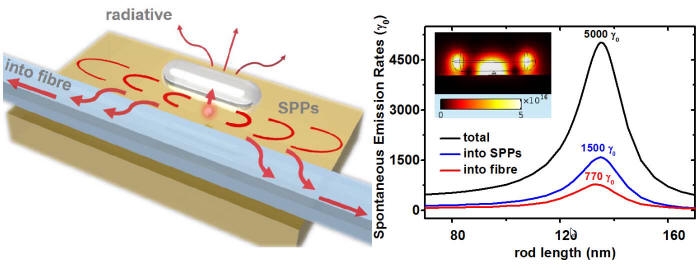Efficient Single Photon Emission and Collection Based on Excitation of Gap
Surface Plasmons
Time:2015-05-25ClickTimes:
Vice-professor Ying Gu and Academician Qihuang Gong et al. in Peking
University “State Key Laboratory For Artificial Microstructure and Mesoscopic
physics” theoretically demonstrated efficient single photon emission and
one-dimensional low-loss nanoscale guiding by putting quantum emitter into the
nanoscale gap formed by metallic nanorod and nanofilm. This result was published
in Physical Review Letters in 15th of May, 2015. (Efficient Single Photon
Emission and Collection Based on Excitation of Gap Surface Plasmons,PRL 114,
193002 (2015)).The first author is a second-year PHD student Hang Lian, and the
corresponding author is vice-professor Ying Gu.

|
Fig. 1:Schematic diagram of quantum-emitter coupled to metallic
nanorod-nanofilm gap plasmon system with a designed nanofiber.
Fig.
2:Normalized spontaneous emission rates as a function of the length of
the Ag nanorod.
|
Single photon emission is of fundamental interest for research in cavity
quantum electrodynamics (CQED), single photon sources, and cavity-based lasing
processes. Based on the principle of the Purcell effect, the spontaneous
emission rates can be enhanced by the modification of the density of states of
the electromagnetic field. To meet the requirements of on-chip optics, various
nanophotonic structures have been proposed to tailor the emission rates, but
with the drawback of inadequate enhancement of spontaneous emission rates.
Plasmonic structures have been considered to improve on that situation,
specially, gap plasmon structures are proposed as excellent candidates since
they can provide large spontaneous emission enhancement.
By combining the advantages of ultrahigh emission rates in gap plasmon system
with high extraction into low-loss nanofibers, they theoretically demonstrate
the efficient emission and one-dimensional nanoscale guiding in metallic nanorod-coupled
nanofilm structures coupled to dielectric nanofibers. They find the total decay
rates and surface plasmon polariton channel decay rates orders of magnitude
larger than those characteristic of metallic nanofilms alone can be achieved in
ultrastrong hot spots of gap plasmons. For the requirement of practical
applications, propagating single photons with decay rates of290γ0–770γ0 are
guided into the phase-matched low-loss nanofibers. The proposed mechanism
promises to have an important impact on metal-based optical cavities, on-chip
bright single photon sources and plasmon-based nanolasers.
This work was supported by the National Natural Science Foundation of China
“the Major Program”and“Innovative Research Groups”, by the National Key Basic
Research Program “973 project”, and by the support of Peking University “State
Key Laboratory For Artificial Microstructure and Mesoscopic physics”.
Related links:http://dx.doi.org/10.1103/PhysRevLett.114.193002
